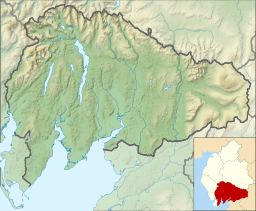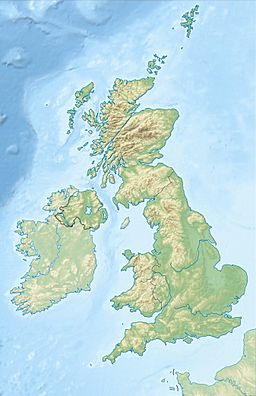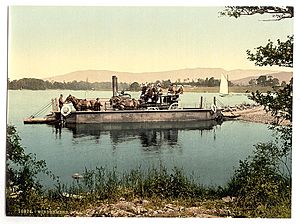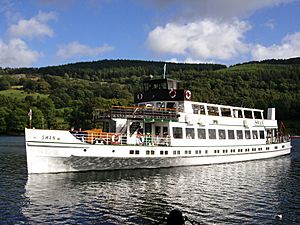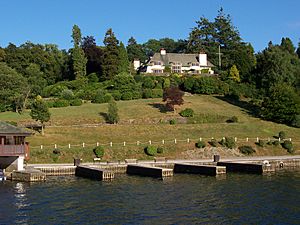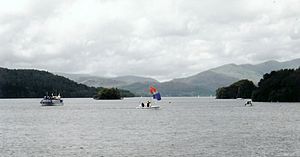Windermere facts for kids
Quick facts for kids Windermere |
|
|---|---|

View of Windermere
|
|
| Location | Lake District National Park |
| Coordinates | 54°21′30″N 2°56′10″W / 54.35833°N 2.93611°W |
| Type | Ribbon mere |
| Primary inflows | Brathay, Rothay, Trout Beck, Cunsey Beck |
| Primary outflows | River Leven |
| Basin countries | United Kingdom |
| Max. length | 11.23 miles (18.07 km) |
| Max. width | 0.93 miles (1.50 km) |
| Surface area | 14.73 km2 (5.69 sq mi) |
| Max. depth | 219 ft (67 m) |
| Surface elevation | 128 ft (39 m) |
| Islands | 19 (Belle Isle, see list) |
Windermere is a beautiful and long lake in Cumbria, England. It is part of the famous Lake District. People sometimes call it Lake Windermere to avoid confusing it with the nearby town of Windermere.
This lake is the largest in England. It holds the record for length, area, and how much water it contains. However, it is smaller than some of the very large lakes in Scotland and Northern Ireland.
Windermere is about 11 miles (18 km) long and 1 mile (1.6 km) wide at its widest point. It can be as deep as 210 feet (64 meters). The lake sits about 128 feet (39 meters) above sea level. Its water flows out into the River Leven, which then goes into Morecambe Bay.
The lake is a popular spot for holidays and summer homes. This started when a railway line arrived in 1847. Scientists also study the lake. The Freshwater Biological Association was set up here in 1929. Much important work on how lake ecosystems work was done at Windermere.
Contents
What's in a Name? The Story of Windermere
The name 'Windermere' likely means "Winand or Vinand's lake." Experts think 'Vinandr' might be an old Swedish name. Another idea is that it comes from a German name, 'Wīnand'.
The second part of the name, 'mere', is an old English word for 'lake' or 'pool'. So, for a long time, it was known as "Winander Mere" or "Winandermere."
Even though its name suggests it's a "mere" (a wide, shallow lake), Windermere is actually quite deep. It has different water layers, which is not typical for a mere. People who lived in the area long ago didn't often use the word "lake." They called it "Windermere Water" or "Windermer Watter."
The town of Windermere got its name from the lake. Some people say "Lake Windermere" to tell the difference between the lake and the town.
Exploring Windermere's Geography
Windermere is a long and narrow lake. It sits in a valley that was carved out by glaciers a very long time ago. The lake formed after the last Ice Age, between 17,000 and 14,700 years ago. It was filled with meltwater from the retreating ice.
The lake has two main parts, a north basin and a south basin. These parts are different because of the types of rocks underneath them. The north has hard volcanic rocks, while the south has softer shales.
The River Leven flows out of the very south end of the lake. Several rivers flow into Windermere, including the Brathay, Rothay, Trout Beck, and Cunsey Beck. The lake is surrounded by hills, which are great for walking. To the north are the higher mountains of the Lake District.
The exact length of the lake can be debated. It's about 11.23 miles (18.07 km) if measured from Newby Bridge. If measured from Lakeside, it's about 10.5 miles (16.9 km). The lake is up to 1 mile (1.6 km) wide and covers an area of 5.69 square miles (14.73 km²). The deepest point of the lake is actually below sea level.
Only one town, Bowness-on-Windermere, is directly on the lake's shore. The village of Windermere is about a 20-minute walk from the lake. It only grew after the railway arrived in 1847. The railway station was built in an open area. The village that grew around it was first called Birthwaite. Around 1859, people started calling it Windermere. This made the people of Bowness, who had been the main center for centuries, a bit annoyed. Today, the two places are under one council, and the area between them is mostly built up. Windermere railway station is a key spot for trains and buses. You can catch fast trains to many major cities from nearby Oxenholme.
Islands of Windermere
Windermere has eighteen islands. The biggest one is Belle Isle, which is privately owned. It's about half a mile (1 km) long and 40 acres (16 hectares) in size. Long ago, it was called Lang Holme.
The other islands are much smaller. They are often called "holmes," which is an old word for a small island.
- Lady Holme is named after a small church that used to be there.
- Other islands include Bee Holme, Blake Holme, Crow Holme, Birk Holme (also called Fir Holme), Grass Holme, Lilies of the Valley (East and West), Ling Holme, Hawes Holme, Hen Holme, Maiden Holme (the smallest), Ramp Holme, Rough Holme, Snake Holme, Thompson Holme (the second largest), and Silver Holme.
Boating Adventures on Windermere
Steamer and Launch Boat Rides
You can take passenger boats all along the lake. They go from Lakeside railway station at the south end to Waterhead Bay near Ambleside in the north. Boats also stop at Bowness and Brockhole. Some boats do the whole trip, while others offer shorter cruises.
These boat services have a long history. They were once run by the railway company. Today, Windermere Lake Cruises Ltd operates three large old railway boats and many smaller, newer boats. Three of the original boats are still used: the MV Tern (from 1891), the MV Teal (from 1936), and the MV Swan (from 1938). Even though they are often called "steamers," they all use diesel engines now.
Ferries Crossing the Lake

The Windermere Ferry carries cars and people across the lake. It goes from Ferry Nab on the east side to Far Sawrey on the west side. This ferry is part of the B5285. There are also two passenger ferries that run only in summer. One crosses from Lakeside station to Fell Foot Park. The other connects Bowness with Far Sawrey.
Boat Clubs and Racing
Windermere is home to five large boating clubs. These include the South Windermere Sailing Club, Windermere Motor Boat Racing Club, the Lake District Boat Club, the Royal Windermere Yacht Club, and the Windermere Cruising Association. These clubs organize many events, including races.
The South Windermere Sailing Club, started in 1961, is known for training many successful British dinghy racing champions. The tricky winds on the lake help sailors learn to adapt quickly.
In 2015, the Windermere Rowing Club started at Fell Foot Park. It's a growing club for rowers.
Speed Records on the Water
On June 13, 1930, Sir Henry Segrave set a new world water speed record on Windermere. His boat, Miss England II, reached an average speed of 98.76 mph (158.94 km/h). Sadly, during a later run, the boat flipped over. Segrave was rescued but died from his injuries. He was one of the few people to hold both the land and water speed records at the same time.
Racer Norman Buckley also set several world water speed records on Windermere in the 1950s.
Speed Limits on the Lake

For many years, fast powerboating and water-skiing were popular on the lake. In 2000, the Lake District National Park Authority introduced a new rule. It set a 10-knot (11.5 mph or 18.5 km/h) speed limit for all powered boats on the lake. This rule became fully enforced in 2005. Even with the limits, some people still use powerboats on the lake.
Windermere Jetty: Museum of Boats, Steam and Stories
The Windermere Steamboat Museum, now called the Windermere Jetty: Museum of Boats, Steam and Stories, is located in Bowness. It has a collection of old steam boats, some dating back to 1850. It also features sailing boats, canoes, and information about the famous Swallows and Amazons books. The museum was closed for a while for updates and reopened in March 2019.
Windermere Water Bus Service
Since 2005, there have been plans to expand water bus services on Windermere. In 2009, Windermere Lake Cruises started adding more stops around the lake. The goal is to make it easier for people to travel around the lake by boat.
Swimming in Windermere
Great North Swim Event
On September 13, 2008, Windermere hosted the first Great North Swim. This event is a 1-mile (1.6 km) open water swim. The second swim in 2009 had 6,000 swimmers, making it the biggest open water swim in the UK.
Three Lakes Challenge
The 40-mile (64 km) Three Lakes Challenge is a swimming challenge. It involves swimming the length of Loch Awe in Scotland (25 miles or 40 km), then driving to Windermere and swimming its length (10.5 miles or 16.9 km), and finally driving to Wales to swim the length of Bala Lake (4 miles or 6.4 km). This challenge is like the National Three Peaks Challenge, but for swimming.
Windermere in Popular Culture
William Wordsworth, a famous poet, wrote about the beautiful view of Windermere in his poem The Prelude. He described seeing the lake "like a vast river, stretching in the sun."
Oscar Wilde started writing his play Lady Windermere's Fan while visiting the Lake District in 1891.
The children's books by Arthur Ransome, starting with Swallows and Amazons, are set around a fictional lake inspired by Windermere and Coniston Water. Parts of a 1962 TV series based on Swallows and Amazons were filmed at a boathouse on Windermere.
Hollywood comedian Stan Laurel visited Windermere often as a child. He was born nearby in Ulverston.
The lake gave its name to a group of 300 Jewish boys, known as the "Windermere Boys." They survived Auschwitz and came to live near Windermere in 1945. This rescue was shown in a BBC drama called The Windermere Children in 2020.
Some people believe there might be a lake monster in Windermere, like the one in Loch Ness. In 2011, some unusual photos were taken of this supposed creature, which has been playfully nicknamed "Bownessie."
In 2017, scenes for the 2018 live-action film Peter Rabbit were filmed in Windermere and Ambleside. The stories of Peter Rabbit are strongly connected to this area.
Singer Taylor Swift mentions "Windermere peaks" and Wordsworth in her song "The Lakes." She writes about wanting to go "to the lakes where all the poets went to die."
|
See also
 In Spanish: Windermere para niños
In Spanish: Windermere para niños



